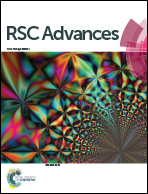A glucosyl triblock copolymer: synthesis and its injectable thermo- and pH-responsive behaviours
Abstract
A new glucosyl triblock copolymer, poly(acryloyl glucofuranose)-block-poly(N-isopropyl acrylamide)-block-poly(acrylic acid) (PAG-b-PNIPAM-b-PAA, i.e., PGNA), was first synthesized from 3-O-acryloyl-1,2;5,6-di-O-isopropylidene-α-D-(−)-glucofuranose (ADIPG), tert-butyl acrylate (tBA) and N-isopropyl acrylamide (NIPAM) in the presence of the initiator 2,2-azoisobutyronitrile (AIBN) by sequential reversible addition–fragmentation chain transfer (RAFT) polymerization. In this RAFT process, 2,2′-thiocarbonylbis(sulfanediyl)bis(2-methylpropanoic acid) (CMP) was synthesized and used as a chain transfer agent. PGNA and the reaction intermediates were characterized by FT-IR, HNMR and GPC. When heated, the aqueous PGNA copolymer solution exhibits good sol–gel phase transition behaviours. Meanwhile, the formed hydrogels are also sensitive to the pH. When the copolymer solution is injected into a living Sprague Dawley (SD) rat, an in situ gel is formed within 3 minutes. By using acetylsalicylic acid (aspirin) as a model, drug release tests show that the maximum releasing value is approximately 76% under physiological conditions (pH 7.4, 37 °C). The synthesized triblock copolymer shows no apparent cytotoxicity towards L929 fibroblast cells according to an in vitro cytotoxicity test (MTT assay).


 Please wait while we load your content...
Please wait while we load your content...